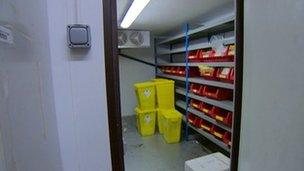Wetherby to Waco - DNA lab's demise
- Published

The laboratory at Wetherby dealt with DNA from the Waco siege
Scientists working at the Forensic Science Service laboratories in West Yorkshire led the world in DNA profiling, the senior scientist at the site said.
The 150-strong team of experts at the lab off Audby Lane handled crucial evidence from a number of high-profile cases for police forces across the globe.
But 35 years after it opened and began using the cutting-edge forensic techniques that were the stuff of television dramas, its doors have shut for the last time.
Principal Forensic Scientist Tim Clayton said the closure would "lead to the loss of 1,000 years' experience".
Forensic work has been distributed to police forces and private sector providers because the Home Office said the service was economically unviable and incurred "huge losses".
The union Prospect said it was "deeply disappointed" by the closure.
'Historical accident'
Mr Clayton said that during a "purple patch" of a decade from the early 1990s most of the major DNA investigations across the world went through the laboratory.

Huge safes at the site held high-profile forensic evidence from around the world.
He said: "This lab had, by historical accident, developed DNA technology that developed into the [DNA] database.
"From 1993 this lab had a world-leading role despite its minor geographical significance, leading the whole of the UK and international excellence in the field of DNA.
"We had between 30 to 40 people working on the DNA cases, in a lab that was subject to an arson attack a few years ago."
The laboratory at Wetherby has dealt with cases as diverse as the bodies recovered from the Waco siege at the Branch Davidians compound in Texas in 1993, to the assassination of the Swedish prime minister Olof Palme in 1986 and the disappearance of Huddersfield man Peter Falconio in Australia in July 2001.
Evidence from the Yorkshire Ripper murders, the disappearance of Dewsbury youngster Shannon Matthews and the death of Lesley Molseed was also analysed at the laboratory.
Shoe fetishist
In November 2008 at Leeds Crown Court jurors were told that forensic scientists considered the kidnapped youngster Shannon Matthews had been drugged.
The court heard the then nine-year-old Shannon had been given the sedative drug temazepam for up to 20 months before her disappearance.
The evidence had come from scientists analysing strands of the child's hair that were found to contain traces of the drug.
In July 2006 printing firm manager James Lloyd, 49, a shoe fetishist of Thurnscoe, South Yorkshire, admitted raping four women and trying to rape two others.
Lloyd was traced when DNA from his sister, taken when she was arrested on an unrelated matter, was matched to samples taken at the time of the offences.
His conviction was hailed by police as the biggest victory yet in a "cold case" using this type of DNA evidence.
All the case files stored in huge safes at the site are to be transferred to the forensics archive in Birmingham.
Mr Clayton said for all the scientists employed in Wetherby the work had "never been just a job, it was a vocation".
And he said the closure of the doors on Friday was for many scientists there "the end of a way of life".
- Published27 March 2012